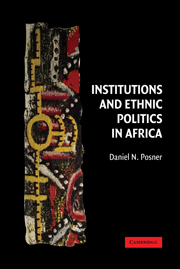Book contents
- Frontmatter
- Contents
- Preface
- INSTITUTIONS AND ETHNIC POLITICS IN AFRICA
- 1 Introduction
- I Introduction to Part I
- II Introduction to Part II
- III Introduction to Part III
- IV Introduction to Part IV
- 9 Regime Change and Ethnic Politics in Africa
- 10 Beyond Regime Change, Beyond Africa
- Appendices
- Bibliography
- Index
- Titles in the series
9 - Regime Change and Ethnic Politics in Africa
Published online by Cambridge University Press: 05 June 2012
- Frontmatter
- Contents
- Preface
- INSTITUTIONS AND ETHNIC POLITICS IN AFRICA
- 1 Introduction
- I Introduction to Part I
- II Introduction to Part II
- III Introduction to Part III
- IV Introduction to Part IV
- 9 Regime Change and Ethnic Politics in Africa
- 10 Beyond Regime Change, Beyond Africa
- Appendices
- Bibliography
- Index
- Titles in the series
Summary
Do the Zambian findings presented in this book travel to other African nations? Is there any evidence that transitions between one-party and multi-party rule in other African countries have brought changes in the kinds of ethnic cleavages that structure political competition and coalition-building? More than two dozen African nations have held parliamentary elections under both single-party and multi-party political systems, so in principle it should be possible to test whether the Zambian results hold elsewhere in the region. For them to be eligible as comparison cases, the countries would have to have multi-dimensional ethnic cleavage structures (so variation in the cleavage outcome is possible) and to be places where ethnicity is understood by voters to convey information about how politicians distribute patronage. Nearly all African countries meet both of these criteria. Almost all have local cleavages defined by tribal affiliation or clan membership and national-scale divisions based on religion, language, or region. A handful of African countries – Sudan, Zimbabwe, Mauritius, Tanzania, South Africa – have significant racial cleavages as well.
As for the role that ethnicity plays, Africa is a region whose poverty and weak government institutions lead citizens to view the state as a resource to be consumed by the ethnic kin of those who control its offices. Young and Turner summarize the partrimonial basis of African politics well:
In the richly evocative Nigerian phrase, politics was “cutting the national cake.” The output of the state was perceived as divisible into slices of possibly unequal size, sweet to the taste, and intended to be eaten. […]
- Type
- Chapter
- Information
- Institutions and Ethnic Politics in Africa , pp. 256 - 273Publisher: Cambridge University PressPrint publication year: 2005

